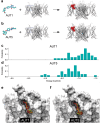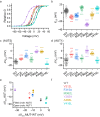The binding and mechanism of a positive allosteric modulator of Kv3 channels
- PMID: 38514618
- PMCID: PMC10957983
- DOI: 10.1038/s41467-024-46813-8
The binding and mechanism of a positive allosteric modulator of Kv3 channels
Abstract
Small-molecule modulators of diverse voltage-gated K+ (Kv) channels may help treat a wide range of neurological disorders. However, developing effective modulators requires understanding of their mechanism of action. We apply an orthogonal approach to elucidate the mechanism of action of an imidazolidinedione derivative (AUT5), a highly selective positive allosteric modulator of Kv3.1 and Kv3.2 channels. AUT5 modulation involves positive cooperativity and preferential stabilization of the open state. The cryo-EM structure of the Kv3.1/AUT5 complex at a resolution of 2.5 Å reveals four equivalent AUT5 binding sites at the extracellular inter-subunit interface between the voltage-sensing and pore domains of the channel's tetrameric assembly. Furthermore, we show that the unique extracellular turret regions of Kv3.1 and Kv3.2 essentially govern the selective positive modulation by AUT5. High-resolution apo and bound structures of Kv3.1 demonstrate how AUT5 binding promotes turret rearrangements and interactions with the voltage-sensing domain to favor the open conformation.
© 2024. The Author(s).
Conflict of interest statement
A.M., N.P., G.A., M.J.G. and C.H.L. are employees and shareholders of Autifony Therapeutics, Ltd. Q.L., L.Z. and M.C. received funding from Autifony Therapeutics, Ltd. to conduct this work. The remaining authors declare no competing interests.
Figures









Similar articles
-
Identification, structural, and biophysical characterization of a positive modulator of human Kv3.1 channels.Proc Natl Acad Sci U S A. 2023 Oct 17;120(42):e2220029120. doi: 10.1073/pnas.2220029120. Epub 2023 Oct 9. Proc Natl Acad Sci U S A. 2023. PMID: 37812700 Free PMC article.
-
Structural insights into the function, dysfunction and modulation of Kv3 channels.Neuropharmacology. 2025 Sep 1;275:110483. doi: 10.1016/j.neuropharm.2025.110483. Epub 2025 Apr 25. Neuropharmacology. 2025. PMID: 40288604 Free PMC article. Review.
-
Apo and ligand-bound high resolution Cryo-EM structures of the human Kv3.1 channel reveal a novel binding site for positive modulators.PNAS Nexus. 2022 Jun 16;1(3):pgac083. doi: 10.1093/pnasnexus/pgac083. eCollection 2022 Jul. PNAS Nexus. 2022. PMID: 36741467 Free PMC article.
-
The ladder-shaped polyether toxin gambierol anchors the gating machinery of Kv3.1 channels in the resting state.J Gen Physiol. 2013 Mar;141(3):359-69. doi: 10.1085/jgp.201210890. Epub 2013 Feb 11. J Gen Physiol. 2013. PMID: 23401573 Free PMC article.
-
The role of Kv3-type potassium channels in cerebellar physiology and behavior.Cerebellum. 2009 Sep;8(3):323-33. doi: 10.1007/s12311-009-0098-4. Epub 2009 Feb 27. Cerebellum. 2009. PMID: 19247732 Review.
Cited by
-
Allostery Illuminated: Harnessing AI and Machine Learning for Drug Discovery.ACS Med Chem Lett. 2024 Aug 30;15(9):1449-1455. doi: 10.1021/acsmedchemlett.4c00260. eCollection 2024 Sep 12. ACS Med Chem Lett. 2024. PMID: 39291033 Review.
-
Effects of β-adrenoceptor antagonist and 5-HT1A and 5-HT1B receptor antagonist alprenolol on human Kv1.3 currents.Korean J Physiol Pharmacol. 2025 Sep 1;29(5):649-658. doi: 10.4196/kjpp.25.098. Epub 2025 Jul 3. Korean J Physiol Pharmacol. 2025. PMID: 40605329 Free PMC article.
-
Effects of moderate static magnetic fields on voltage-gated potassium ion channels in sympathetic neuron-like PC12 cells.Physiol Rep. 2025 Mar;13(6):e70236. doi: 10.14814/phy2.70236. Physiol Rep. 2025. PMID: 40119575 Free PMC article.
-
Voltage-gated potassium channels as a potential therapeutic target for the treatment of neurological and psychiatric disorders.Front Cell Neurosci. 2024 Oct 1;18:1449151. doi: 10.3389/fncel.2024.1449151. eCollection 2024. Front Cell Neurosci. 2024. PMID: 39411003 Free PMC article. Review.
-
Structural basis for the subtype-selectivity of KCa2.2 channel activators.Res Sq [Preprint]. 2025 May 16:rs.3.rs-6568445. doi: 10.21203/rs.3.rs-6568445/v1. Res Sq. 2025. PMID: 40470184 Free PMC article. Preprint.
References
-
- Hille, B. Ionic channels of excitable membranes. 2nd ed. (Sinauer Associates, 2001).
MeSH terms
Substances
Grants and funding
LinkOut - more resources
Full Text Sources

